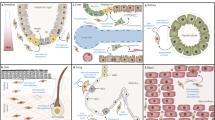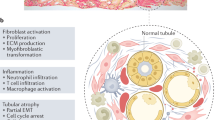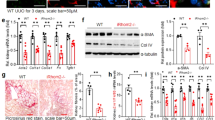Abstract
Fibroblasts are one of the most important and episodically active cell types in the kidney. Under normal conditions, these cells provide a delicate collagenous matrix that partitions the interstitial spaces between nephrons, blood vessels and the renal capsule. Fibroblasts also remodel the interstitium as kidneys grow with age. This episodic activity of various fibroblast populations has a biological basis. Most fibroblasts are created locally through a process called epithelial–mesenchymal transition (EMT) and, once formed, they can proliferate in response to local mitogens. EMT is driven by an alteration in the balance of local cytokine concentrations that reverses the differentiation of selected epithelia along tubular nephrons. During persistent injury and inflammation, fibroblasts further increase their numbers and secrete excess interstitial collagens, and EMT is particularly aggressive in this setting. The mechanisms by which fibroblasts simultaneously destroy normal interstitial architecture and disable epithelial nephrons are more comprehensible today. Recent therapeutic clues for attenuating fibroblast formation during renal fibrogenesis also suggest an advantage in shifting local cytokine balance to favor mesenchymal–epithelial transition. This review examines these issues and identifies new targets for the treatment of one of the most difficult problems facing clinical nephrology.
Key Points
-
Epithelial–mesenchymal transition, driven by cytokines, is the mechanism by which fibroblasts are generated locally
-
In normal kidneys, fibroblasts help to maintain interstitial physiology and remodel epithelia during growth
-
During inflammatory injury, aggressive epithelial–mesenchymal transition generates excessive extracellular matrix, causing fibrosis
-
There are few clinical tools for effective management of fibrosis
-
Recently identified targets for intervention include inhibitors of platelet-derived growth factor receptors and agonists of bone morphogenetic protein-7
This is a preview of subscription content, access via your institution
Access options
Subscribe to this journal
Receive 12 print issues and online access
$209.00 per year
only $17.42 per issue
Buy this article
- Purchase on Springer Link
- Instant access to full article PDF
Prices may be subject to local taxes which are calculated during checkout


Similar content being viewed by others
References
Iwano M and Neilson EG (2004) Mechanisms of tubulointerstitial fibrosis. Curr Opin Nephrol Hypertens 13: 279–284
Harris RC and Neilson EG : Towards a unified hypothesis of renal progression. Ann Rev Med, in press
Strutz F and Neilson EG (2003) New insights into mechanisms of fibrosis in immune renal injury. Springer Semin Immunopathol 24: 459–476
Iwano M et al. (2001) Conditional abatement of tissue fibrosis using nucleoside analogs to selectively corrupt DNA replication in transgenic fibroblasts. Mol Ther 3: 149–159
Kalluri R and Neilson EG (2003) Epithelial-mesenchymal transition and its implications for fibrosis. J Clin Invest 112: 1776–1784
Shook D and Keller R (2003) Mechanisms, mechanics and function of epithelial–mesenchymal transitions in early development. Mech Dev 120: 1351–1383
Karihaloo A et al. (2005) Signals which build a tubule. Nephron Exp Nephrol 100: e40–45
Barasch J et al. (1999) Mesenchymal to epithelial conversion in rat metanephros is induced by LIF. Cell 99: 377–386
Oliver JA et al. (2004) The renal papilla is a niche for adult kidney stem cells. J Clin Invest 114: 795–804
Lin F et al. (2005) Intrarenal cells, not bone marrow-derived cells, are the major source for regeneration in postischemic kidney. J Clin Invest 115: 1756–1764
Strutz F et al. (1995) Identification and characterization of a fibroblast marker: FSP1. J Cell Biol 130: 393–405
Iwano M et al. (2002) Evidence that fibroblasts derive from epithelium during tissue fibrosis. J Clin Invest 110: 341–350
Alvarez RJ et al. (1992) Biosynthetic and proliferative characteristics of tubulointerstitial fibroblasts probed with paracrine cytokines. Kidney Int 41: 14–23
Zeisberg M et al. (2003) BMP-7 counteracts TGF-beta1-induced epithelial-to-mesenchymal transition and reverses chronic renal injury. Nat Med 9: 964–968
Liu Y (2004) Hepatocyte growth factor in kidney fibrosis: therapeutic potential and mechanisms of action. Am J Physiol Renal Physiol 287: F7–F16
Zeisberg M and Kalluri R (2004) The role of epithelial-to-mesenchymal transition in renal fibrosis. J Mol Med 82: 175–181
Abe R et al. (2001) Peripheral blood fibrocytes: differentiation pathway and migration to wound sites. J Immunol 166: 7556–7562
Faulkner JL et al. (2005) Origin of interstitial fibroblasts in an accelerated model of angiotensin II-induced renal fibrosis. Am J Pathol 167: 1193–1205
Leung EW et al. (2000) Extracellular matrix components in retrocorneal fibrous membrane in comparison to corneal endothelium and Descemets membrane. Mol Vis 6: 15–23
Neilson EG (2005) Setting a trap for tissue fibrosis. Nat Med 11: 373–374
Strutz F et al. (2002) Role of basic fibroblast growth factor-2 in epithelial-mesenchymal transformation. Kidney Int 61: 1714–1728
Okada H et al. (1997) The early role of FSP1 in epithelial–mesenchymal transformation. Am J Physiol 273: 563–574
Stachowiak MK et al. (2003) Integrative nuclear FGFR1 signaling (INFS) as a part of a universal “feed-forward-and-gate” signaling module that controls cell growth and differentiation. J Cell Biochem 90: 662–691
Shi Y and Massague J (2003) Mechanisms of TGF-beta signaling from cell membrane to the nucleus. Cell 113: 685–700
Sato M et al. (2003) Targeted disruption of TGF-beta1/Smad3 signaling protects against renal tubulointerstitial fibrosis induced by unilateral ureteral obstruction. J Clin Invest 112: 1486–1494
Kim K et al. (2002) Direct evidence for a role of beta-catenin/LEF-1 signaling pathway in induction of EMT. Cell Biol Int 26: 463–476
Labbe E et al. (2000) Association of Smads with lymphoid enhancer binding factor 1/T cell-specific factor mediates cooperative signaling by the transforming growth factor-beta and wnt pathways. Proc Natl Acad Sci USA 97: 8358–8363
Hussein SM et al. (2003) Smad4 and beta-catenin co-activators functionally interact with lymphoid-enhancing factor to regulate graded expression of Msx2. J Biol Chem 278: 48805–48814
Yang J et al. (2004) Twist, a master regulator of morphogenesis, plays an essential role in tumor metastasis. Cell 117: 927–939
Nieto MA (2002) The snail superfamily of zinc-finger transcription factors. Nat Rev Mol Cell Biol 3: 155–166
Okada H et al. (2000) Progressive renal fibrosis in murine polycystic kidney disease: an immunohistochemical observation. Kidney Int 58: 587–597
Boccaccio C et al. (1998) Induction of epithelial tubules by growth factor HGF depends on the STAT pathway. Nature 391: 285–288
Yang J and Liu Y (2002) Blockage of tubular epithelial to myofibroblast transition by hepatocyte growth factor prevents renal interstitial fibrosis. J Am Soc Nephrol 13: 96–107
Wang S et al. (2003) Bone morphogenic protein-7 (BMP-7), a novel therapy for diabetic nephropathy. Kidney Int 63: 2037–2049
Morrissey J et al. (2002) Bone morphogenetic protein-7 improves renal fibrosis and accelerates the return of renal function. J Am Soc Nephrol 13 (Suppl 1): S14–S21
Hu MC and Rosenblum ND (2005) Smad1, beta-catenin and Tcf4 associate in a molecular complex with the Myc promoter in dysplastic renal tissue and cooperate to control Myc transcription. Development 132: 215–225
Bonner JC (2004) Regulation of PDGF and its receptors in fibrotic diseases. Cytokine Growth Factor Rev 15: 255–273
Balemans W and Van Hul W (2002) Extracellular regulation of BMP signaling in vertebrates: a cocktail of modulators. Dev Biol 250: 231–250
Border WA et al. (1992) Natural inhibitor of transforming growth factor-beta protects against scarring in experimental kidney disease. Nature 360: 361–364
Abreu JG et al. (2002) Connective-tissue growth factor (CTGF) modulates cell signalling by BMP and TGF-beta. Nat Cell Biol 4: 599–604
Lin J et al. (2005) Kielin/chordin-like protein, a novel enhancer of BMP signaling, attenuates renal fibrotic disease. Nat Med 11: 387–393
Yee J et al. (1991) Tubulointerstitial injury following glomerulonephritis. Semin Nephrol 11: 361–366
Kriz W (2002) Podocyte is the major culprit accounting for the progression of chronic renal disease. Microsc Res Tech 57: 189–195
Brenner BM (2002) Remission of renal disease: recounting the challenge, acquiring the goal. J Clin Invest 110: 1753–1758
Perico N et al. (2005) Pathophysiology of disease progression in proteinuric nephropathies. Kidney Int Suppl: S79–S82
Eppel GA et al. (1999) The return of glomerular-filtered albumin to the rat renal vein. Kidney Int 55: 1861–1870
Hirschberg R and Wang S (2005) Proteinuria and growth factors in the development of tubulointerstitial injury and scarring in kidney disease. Curr Opin Nephrol Hypertens 14: 43–52
Donadelli R et al. (2000) Protein traffic activates NF-kB gene signaling and promotes MCP-1-dependent interstitial inflammation. Am J Kidney Dis 36: 1226–1241
Morigi M et al. (2002) Protein overload-induced NF-κB activation in proximal tubular cells requires H2O2 through a PKC-dependent pathway. J Am Soc Nephrol 13: 1179–1189
Zoja C et al. (1998) Protein overload stimulates RANTES production by proximal tubular cells depending on NF-κB activation. Kidney Int 53: 1608–1615
Iglesias J and Levine JS (2001) Albuminuria and renal injury—beware of proteins bearing gifts. Nephrol Dial Transplant 16: 215–218
Kees-Folts D et al. (1994) Tubular catabolism of albumin is associated with the release of an inflammatory lipid. Kidney Int 45: 1697–1709
Wang SN et al. (1999) Glomerular ultrafiltration and apical tubular action of IGF-I, TGF-beta, and HGF in nephrotic syndrome. Kidney Int 56: 1247–1251
Wolf G and Ritz E (2005) Combination therapy with ACE inhibitors and angiotensin II receptor blockers to halt progression of chronic renal disease: pathophysiology and indications. Kidney Int 67: 799–812
Cao Z and Cooper ME (2001) Role of angiotensin II in tubulointerstitial injury. Semin Nephrol 21: 554–562
Wolf G et al. (2004) Albumin up-regulates the type II transforming growth factor-beta receptor in cultured proximal tubular cells. Kidney Int 66: 1849–1858
Anders HJ et al. (2003) Chemokines and chemokine receptors are involved in the resolution or progression of renal disease. Kidney Int 63: 401–415
Klahr S and Morrissey JJ (1998) The role of growth factors, cytokines, and vasoactive compounds in obstructive nephropathy. Semin Nephrol 18: 622–632
Chiurchiu C et al. (2005) Angiotensin-converting enzyme inhibition and renal protection in nondiabetic patients: the data of the meta-analyses. J Am Soc Nephrol 16 (Suppl 1): S58–S63
Lewis EJ and Lewis JB (2004) ACE inhibitors versus angiotensin receptor blockers in diabetic nephropathy: is there a winner? J Am Soc Nephrol 15: 1358–1360
Moses HL et al. (1987) Transforming growth factor beta regulation of cell proliferation. J Cell Physiol (Suppl 5): S1–S7
Fujigaki Y et al. (2001) Cytokines and cell cycle regulation in the fibrous progression of crescent formation in antiglomerular basement membrane nephritis of WKY rats. Virchows Arch 439: 35–45
Moustakas A et al. (2002) Mechanisms of TGF-beta signaling in regulation of cell growth and differentiation. Immunol Lett 82: 85–91
Takahashi E et al. (2004) Snail regulates p21(WAF/CIP1) expression in cooperation with E2A and Twist. Biochem Biophys Res Commun 325: 1136–1144
Tang WW et al. (1996) Platelet-derived growth factor-BB induces renal tubulointerstitial myofibroblast formation and tubulointerstitial fibrosis. Am J Pathol 148: 1169–1180
Satoh T et al. (1993) Platelet-derived growth factor receptor mediates activation of ras through different signaling pathways in different cell types. Mol Cell Biol 13: 3706–3713
Espada J et al. (1999) H-Ras activation promotes cytoplasmic accumulation and phosphoinositide 3-OH kinase association of beta-catenin in epidermal keratinocytes. J Cell Biol 146: 967–980
Levitzki A (2004) PDGF receptor kinase inhibitors for the treatment of PDGF driven diseases. Cytokine Growth Factor Rev 15: 229–235
Mezzano SA et al. (2001) Angiotensin II and renal fibrosis. Hypertension 38: 635–638
Strutz F (2001) Potential methods to prevent interstitial fibrosis in renal disease. Expert Opin Investig Drugs 10: 1989–2001
Acknowledgements
This study was supported by NIH grants DK-46282, HL-68121, and CA-68485.
Author information
Authors and Affiliations
Corresponding author
Ethics declarations
Competing interests
Dr Neilson serves on the Scientific Advisory Boards of BioStratum, Inc. and NephroGenex, Inc.
Rights and permissions
About this article
Cite this article
Neilson, E. Mechanisms of Disease: fibroblasts—a new look at an old problem. Nat Rev Nephrol 2, 101–108 (2006). https://doi.org/10.1038/ncpneph0093
Received:
Accepted:
Issue Date:
DOI: https://doi.org/10.1038/ncpneph0093
This article is cited by
-
Adiponectin Alleviates Intestinal Fibrosis by Enhancing AMP-Activated Protein Kinase Phosphorylation
Digestive Diseases and Sciences (2022)
-
Effect of Shenkang on renal fibrosis and activation of renal interstitial fibroblasts through the JAK2/STAT3 pathway
BMC Complementary Medicine and Therapies (2021)
-
Distinct roles of Dlk1 isoforms in bi-potential differentiation of hepatic stem cells
Stem Cell Research & Therapy (2019)
-
Rhein alleviates renal interstitial fibrosis by inhibiting tubular cell apoptosis in rats
Biological Research (2019)
-
Bone marrow mesenchymal stromal cells attenuate silica-induced pulmonary fibrosis potentially by attenuating Wnt/β-catenin signaling in rats
Stem Cell Research & Therapy (2018)



